Discrimination in Construction: Cousins Refurbishment LTD
VerifiedAdded on 2023/01/12
|27
|5637
|62
Report
AI Summary
This research project investigates nationality discrimination within the construction industry, using Cousins Refurbishment LTD as a case study. The project begins with an introduction outlining the research objectives, rationale, significance, and limitations. A literature review explores existing research on worker experiences of nationality discrimination, its impact on mental and physical health, and organizational strategies to address ethical issues. The methodology chapter details the research design, methods, strategy, and data collection and analysis techniques. The data analysis chapter presents and discusses the findings. The conclusion and recommendations chapter summarizes the key findings and suggests strategies for Cousins Refurbishment LTD to address discrimination. Finally, a personal reflective statement is included, reflecting on the research methods and potential areas for further research.
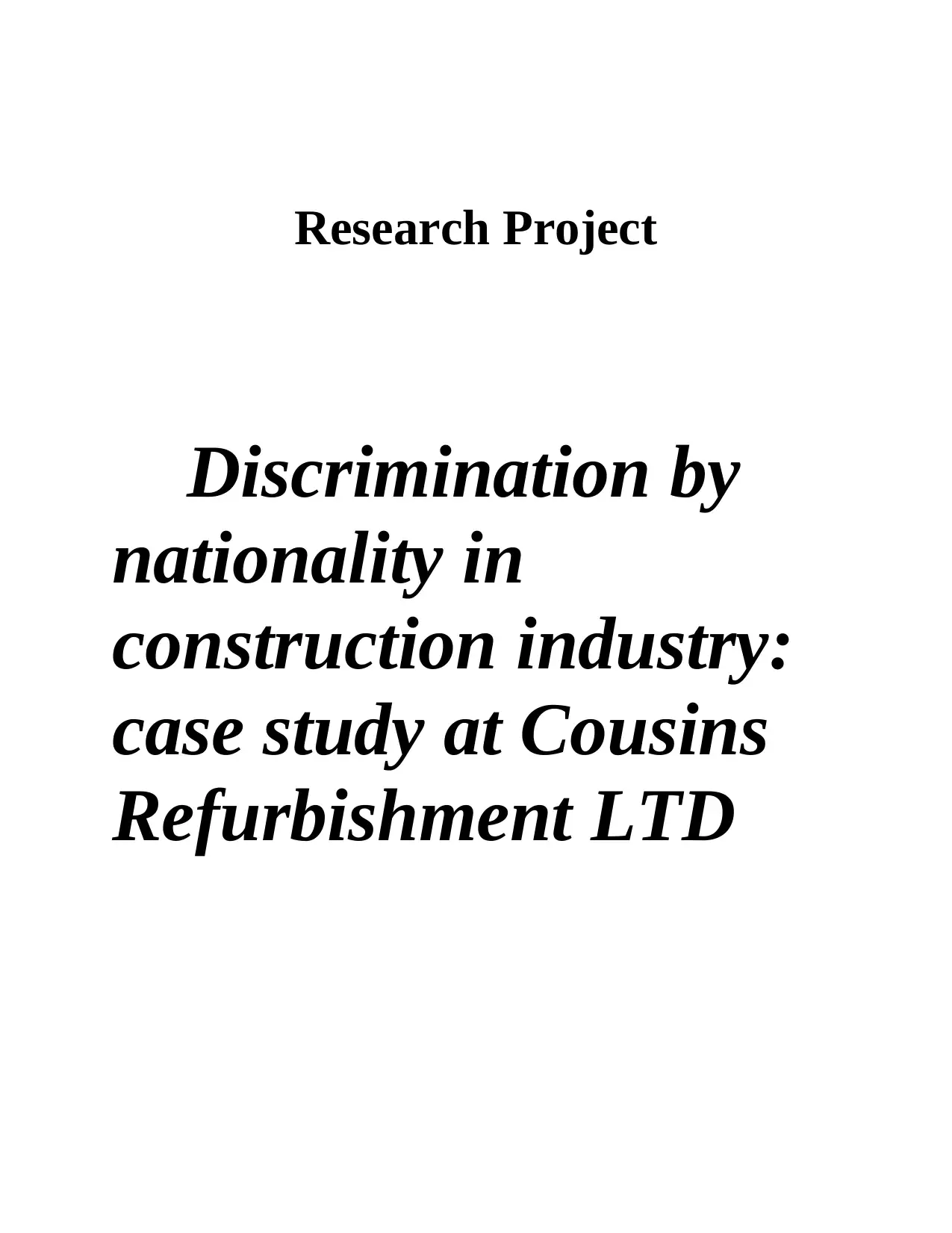
Research Project
Discrimination by
nationality in
construction industry:
case study at Cousins
Refurbishment LTD
Discrimination by
nationality in
construction industry:
case study at Cousins
Refurbishment LTD
Paraphrase This Document
Need a fresh take? Get an instant paraphrase of this document with our AI Paraphraser
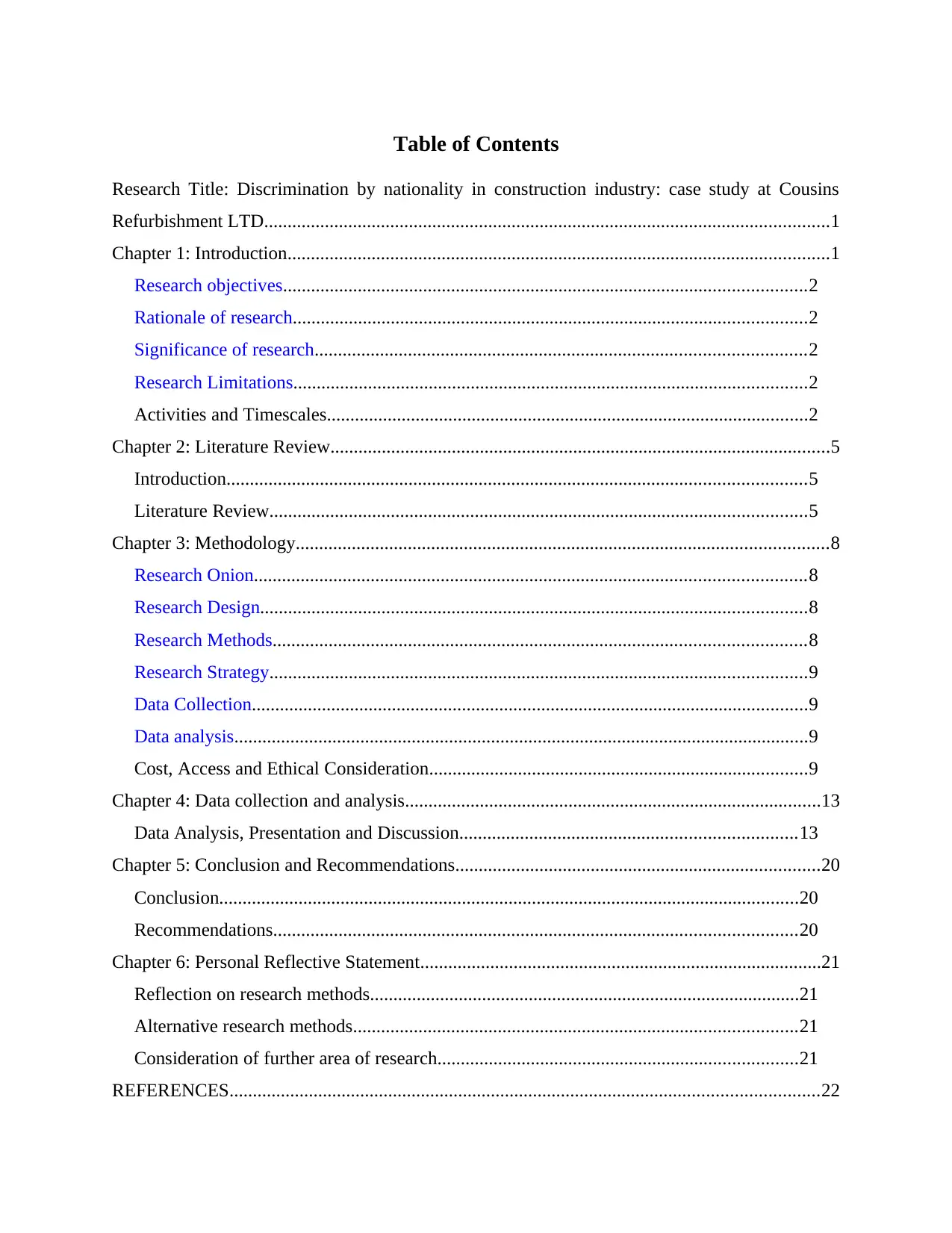
Table of Contents
Research Title: Discrimination by nationality in construction industry: case study at Cousins
Refurbishment LTD.........................................................................................................................1
Chapter 1: Introduction....................................................................................................................1
Research objectives................................................................................................................2
Rationale of research..............................................................................................................2
Significance of research.........................................................................................................2
Research Limitations..............................................................................................................2
Activities and Timescales.......................................................................................................2
Chapter 2: Literature Review...........................................................................................................5
Introduction............................................................................................................................5
Literature Review...................................................................................................................5
Chapter 3: Methodology..................................................................................................................8
Research Onion......................................................................................................................8
Research Design.....................................................................................................................8
Research Methods..................................................................................................................8
Research Strategy...................................................................................................................9
Data Collection.......................................................................................................................9
Data analysis...........................................................................................................................9
Cost, Access and Ethical Consideration.................................................................................9
Chapter 4: Data collection and analysis.........................................................................................13
Data Analysis, Presentation and Discussion........................................................................13
Chapter 5: Conclusion and Recommendations..............................................................................20
Conclusion............................................................................................................................20
Recommendations................................................................................................................20
Chapter 6: Personal Reflective Statement......................................................................................21
Reflection on research methods............................................................................................21
Alternative research methods...............................................................................................21
Consideration of further area of research.............................................................................21
REFERENCES..............................................................................................................................22
Research Title: Discrimination by nationality in construction industry: case study at Cousins
Refurbishment LTD.........................................................................................................................1
Chapter 1: Introduction....................................................................................................................1
Research objectives................................................................................................................2
Rationale of research..............................................................................................................2
Significance of research.........................................................................................................2
Research Limitations..............................................................................................................2
Activities and Timescales.......................................................................................................2
Chapter 2: Literature Review...........................................................................................................5
Introduction............................................................................................................................5
Literature Review...................................................................................................................5
Chapter 3: Methodology..................................................................................................................8
Research Onion......................................................................................................................8
Research Design.....................................................................................................................8
Research Methods..................................................................................................................8
Research Strategy...................................................................................................................9
Data Collection.......................................................................................................................9
Data analysis...........................................................................................................................9
Cost, Access and Ethical Consideration.................................................................................9
Chapter 4: Data collection and analysis.........................................................................................13
Data Analysis, Presentation and Discussion........................................................................13
Chapter 5: Conclusion and Recommendations..............................................................................20
Conclusion............................................................................................................................20
Recommendations................................................................................................................20
Chapter 6: Personal Reflective Statement......................................................................................21
Reflection on research methods............................................................................................21
Alternative research methods...............................................................................................21
Consideration of further area of research.............................................................................21
REFERENCES..............................................................................................................................22

⊘ This is a preview!⊘
Do you want full access?
Subscribe today to unlock all pages.

Trusted by 1+ million students worldwide
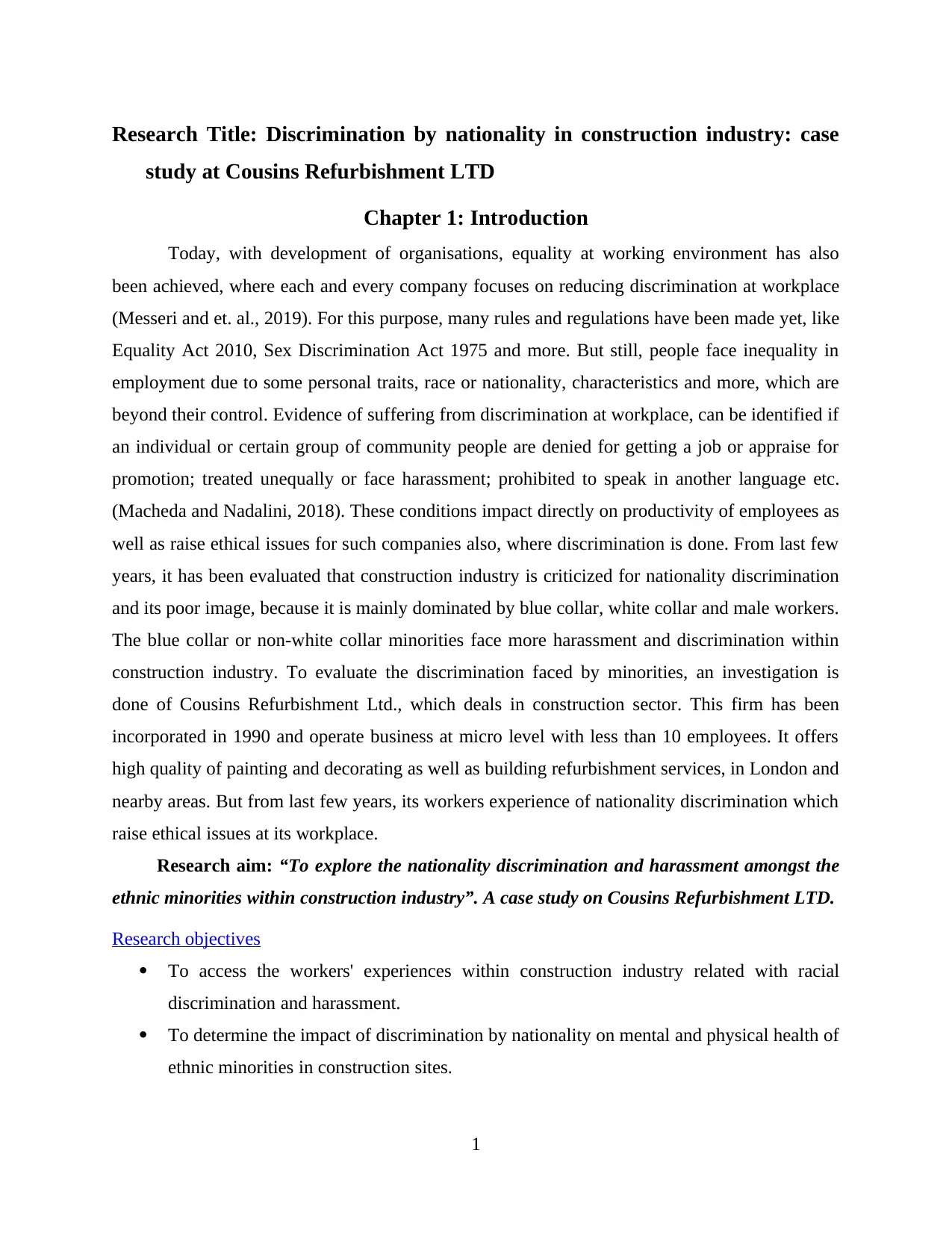
Research Title: Discrimination by nationality in construction industry: case
study at Cousins Refurbishment LTD
Chapter 1: Introduction
Today, with development of organisations, equality at working environment has also
been achieved, where each and every company focuses on reducing discrimination at workplace
(Messeri and et. al., 2019). For this purpose, many rules and regulations have been made yet, like
Equality Act 2010, Sex Discrimination Act 1975 and more. But still, people face inequality in
employment due to some personal traits, race or nationality, characteristics and more, which are
beyond their control. Evidence of suffering from discrimination at workplace, can be identified if
an individual or certain group of community people are denied for getting a job or appraise for
promotion; treated unequally or face harassment; prohibited to speak in another language etc.
(Macheda and Nadalini, 2018). These conditions impact directly on productivity of employees as
well as raise ethical issues for such companies also, where discrimination is done. From last few
years, it has been evaluated that construction industry is criticized for nationality discrimination
and its poor image, because it is mainly dominated by blue collar, white collar and male workers.
The blue collar or non-white collar minorities face more harassment and discrimination within
construction industry. To evaluate the discrimination faced by minorities, an investigation is
done of Cousins Refurbishment Ltd., which deals in construction sector. This firm has been
incorporated in 1990 and operate business at micro level with less than 10 employees. It offers
high quality of painting and decorating as well as building refurbishment services, in London and
nearby areas. But from last few years, its workers experience of nationality discrimination which
raise ethical issues at its workplace.
Research aim: “To explore the nationality discrimination and harassment amongst the
ethnic minorities within construction industry”. A case study on Cousins Refurbishment LTD.
Research objectives
To access the workers' experiences within construction industry related with racial
discrimination and harassment.
To determine the impact of discrimination by nationality on mental and physical health of
ethnic minorities in construction sites.
1
study at Cousins Refurbishment LTD
Chapter 1: Introduction
Today, with development of organisations, equality at working environment has also
been achieved, where each and every company focuses on reducing discrimination at workplace
(Messeri and et. al., 2019). For this purpose, many rules and regulations have been made yet, like
Equality Act 2010, Sex Discrimination Act 1975 and more. But still, people face inequality in
employment due to some personal traits, race or nationality, characteristics and more, which are
beyond their control. Evidence of suffering from discrimination at workplace, can be identified if
an individual or certain group of community people are denied for getting a job or appraise for
promotion; treated unequally or face harassment; prohibited to speak in another language etc.
(Macheda and Nadalini, 2018). These conditions impact directly on productivity of employees as
well as raise ethical issues for such companies also, where discrimination is done. From last few
years, it has been evaluated that construction industry is criticized for nationality discrimination
and its poor image, because it is mainly dominated by blue collar, white collar and male workers.
The blue collar or non-white collar minorities face more harassment and discrimination within
construction industry. To evaluate the discrimination faced by minorities, an investigation is
done of Cousins Refurbishment Ltd., which deals in construction sector. This firm has been
incorporated in 1990 and operate business at micro level with less than 10 employees. It offers
high quality of painting and decorating as well as building refurbishment services, in London and
nearby areas. But from last few years, its workers experience of nationality discrimination which
raise ethical issues at its workplace.
Research aim: “To explore the nationality discrimination and harassment amongst the
ethnic minorities within construction industry”. A case study on Cousins Refurbishment LTD.
Research objectives
To access the workers' experiences within construction industry related with racial
discrimination and harassment.
To determine the impact of discrimination by nationality on mental and physical health of
ethnic minorities in construction sites.
1
Paraphrase This Document
Need a fresh take? Get an instant paraphrase of this document with our AI Paraphraser
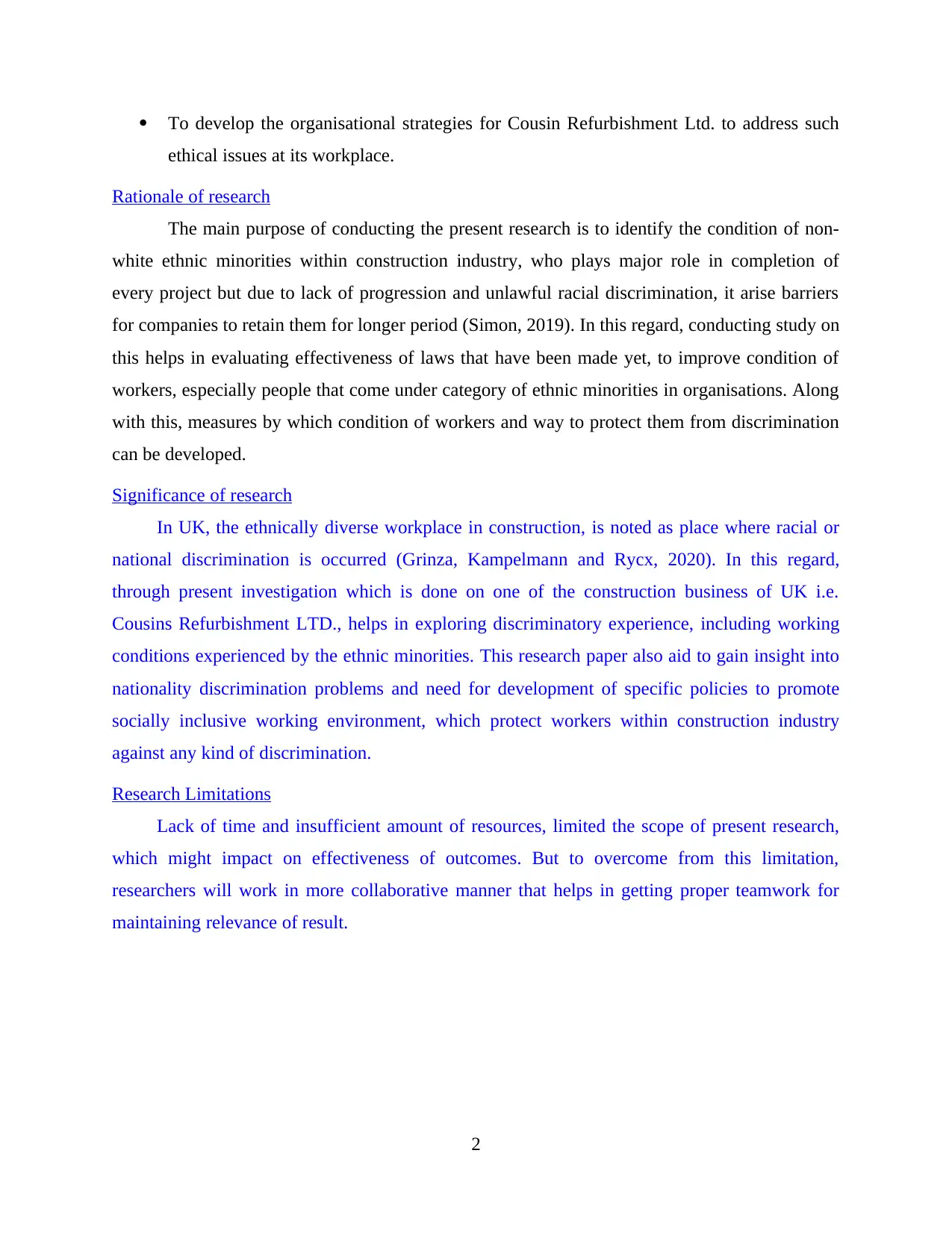
To develop the organisational strategies for Cousin Refurbishment Ltd. to address such
ethical issues at its workplace.
Rationale of research
The main purpose of conducting the present research is to identify the condition of non-
white ethnic minorities within construction industry, who plays major role in completion of
every project but due to lack of progression and unlawful racial discrimination, it arise barriers
for companies to retain them for longer period (Simon, 2019). In this regard, conducting study on
this helps in evaluating effectiveness of laws that have been made yet, to improve condition of
workers, especially people that come under category of ethnic minorities in organisations. Along
with this, measures by which condition of workers and way to protect them from discrimination
can be developed.
Significance of research
In UK, the ethnically diverse workplace in construction, is noted as place where racial or
national discrimination is occurred (Grinza, Kampelmann and Rycx, 2020). In this regard,
through present investigation which is done on one of the construction business of UK i.e.
Cousins Refurbishment LTD., helps in exploring discriminatory experience, including working
conditions experienced by the ethnic minorities. This research paper also aid to gain insight into
nationality discrimination problems and need for development of specific policies to promote
socially inclusive working environment, which protect workers within construction industry
against any kind of discrimination.
Research Limitations
Lack of time and insufficient amount of resources, limited the scope of present research,
which might impact on effectiveness of outcomes. But to overcome from this limitation,
researchers will work in more collaborative manner that helps in getting proper teamwork for
maintaining relevance of result.
2
ethical issues at its workplace.
Rationale of research
The main purpose of conducting the present research is to identify the condition of non-
white ethnic minorities within construction industry, who plays major role in completion of
every project but due to lack of progression and unlawful racial discrimination, it arise barriers
for companies to retain them for longer period (Simon, 2019). In this regard, conducting study on
this helps in evaluating effectiveness of laws that have been made yet, to improve condition of
workers, especially people that come under category of ethnic minorities in organisations. Along
with this, measures by which condition of workers and way to protect them from discrimination
can be developed.
Significance of research
In UK, the ethnically diverse workplace in construction, is noted as place where racial or
national discrimination is occurred (Grinza, Kampelmann and Rycx, 2020). In this regard,
through present investigation which is done on one of the construction business of UK i.e.
Cousins Refurbishment LTD., helps in exploring discriminatory experience, including working
conditions experienced by the ethnic minorities. This research paper also aid to gain insight into
nationality discrimination problems and need for development of specific policies to promote
socially inclusive working environment, which protect workers within construction industry
against any kind of discrimination.
Research Limitations
Lack of time and insufficient amount of resources, limited the scope of present research,
which might impact on effectiveness of outcomes. But to overcome from this limitation,
researchers will work in more collaborative manner that helps in getting proper teamwork for
maintaining relevance of result.
2
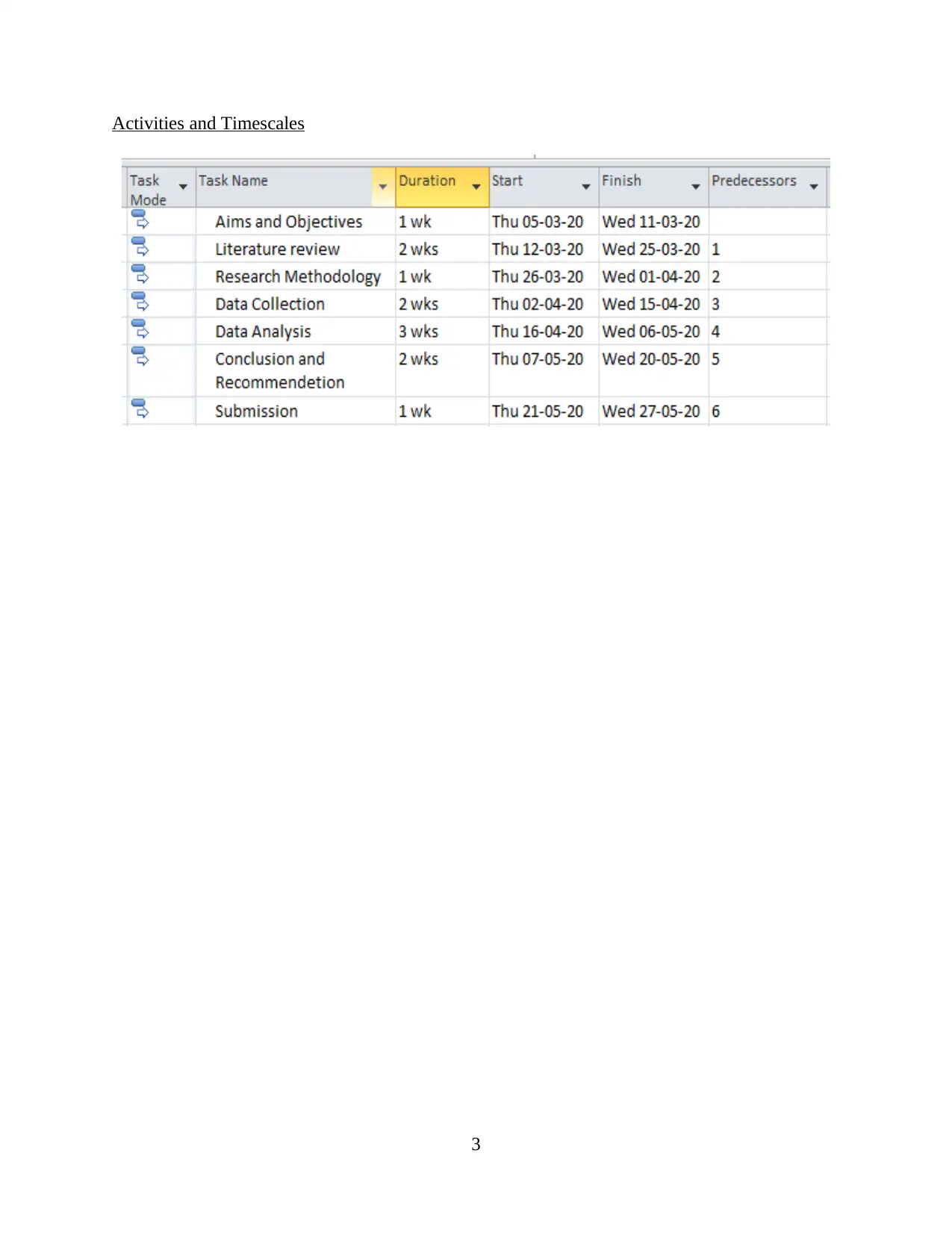
Activities and Timescales
3
3
⊘ This is a preview!⊘
Do you want full access?
Subscribe today to unlock all pages.

Trusted by 1+ million students worldwide
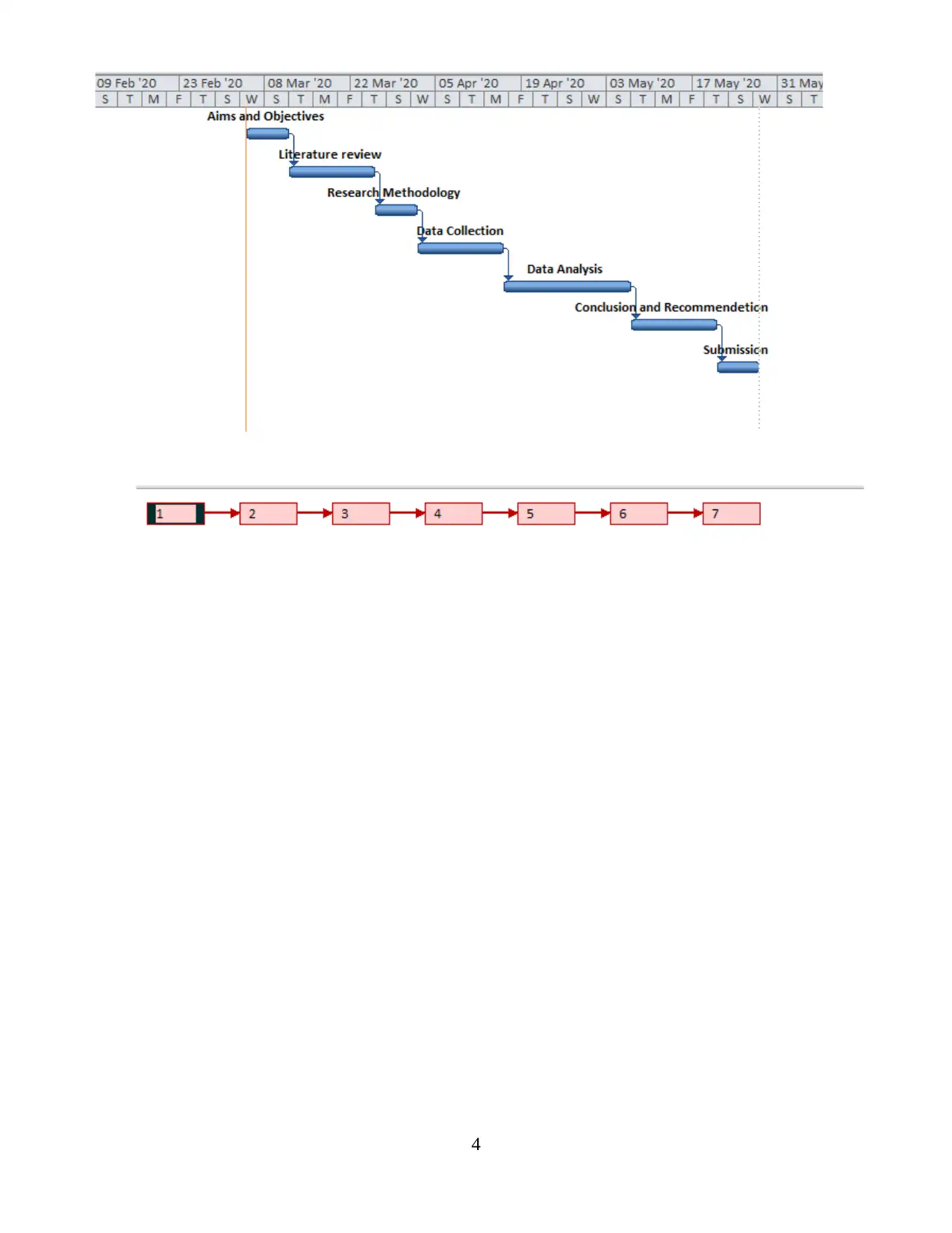
4
Paraphrase This Document
Need a fresh take? Get an instant paraphrase of this document with our AI Paraphraser
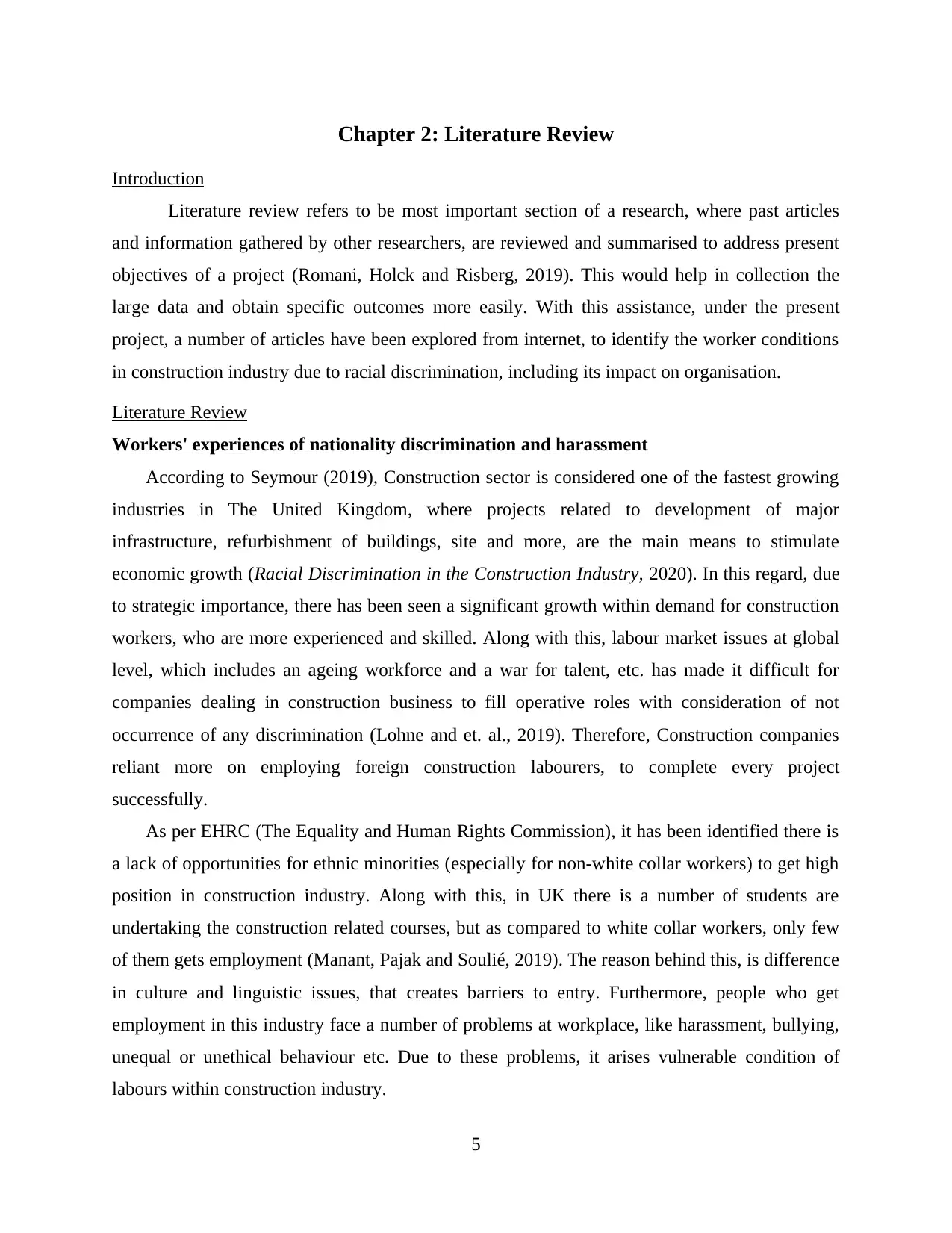
Chapter 2: Literature Review
Introduction
Literature review refers to be most important section of a research, where past articles
and information gathered by other researchers, are reviewed and summarised to address present
objectives of a project (Romani, Holck and Risberg, 2019). This would help in collection the
large data and obtain specific outcomes more easily. With this assistance, under the present
project, a number of articles have been explored from internet, to identify the worker conditions
in construction industry due to racial discrimination, including its impact on organisation.
Literature Review
Workers' experiences of nationality discrimination and harassment
According to Seymour (2019), Construction sector is considered one of the fastest growing
industries in The United Kingdom, where projects related to development of major
infrastructure, refurbishment of buildings, site and more, are the main means to stimulate
economic growth (Racial Discrimination in the Construction Industry, 2020). In this regard, due
to strategic importance, there has been seen a significant growth within demand for construction
workers, who are more experienced and skilled. Along with this, labour market issues at global
level, which includes an ageing workforce and a war for talent, etc. has made it difficult for
companies dealing in construction business to fill operative roles with consideration of not
occurrence of any discrimination (Lohne and et. al., 2019). Therefore, Construction companies
reliant more on employing foreign construction labourers, to complete every project
successfully.
As per EHRC (The Equality and Human Rights Commission), it has been identified there is
a lack of opportunities for ethnic minorities (especially for non-white collar workers) to get high
position in construction industry. Along with this, in UK there is a number of students are
undertaking the construction related courses, but as compared to white collar workers, only few
of them gets employment (Manant, Pajak and Soulié, 2019). The reason behind this, is difference
in culture and linguistic issues, that creates barriers to entry. Furthermore, people who get
employment in this industry face a number of problems at workplace, like harassment, bullying,
unequal or unethical behaviour etc. Due to these problems, it arises vulnerable condition of
labours within construction industry.
5
Introduction
Literature review refers to be most important section of a research, where past articles
and information gathered by other researchers, are reviewed and summarised to address present
objectives of a project (Romani, Holck and Risberg, 2019). This would help in collection the
large data and obtain specific outcomes more easily. With this assistance, under the present
project, a number of articles have been explored from internet, to identify the worker conditions
in construction industry due to racial discrimination, including its impact on organisation.
Literature Review
Workers' experiences of nationality discrimination and harassment
According to Seymour (2019), Construction sector is considered one of the fastest growing
industries in The United Kingdom, where projects related to development of major
infrastructure, refurbishment of buildings, site and more, are the main means to stimulate
economic growth (Racial Discrimination in the Construction Industry, 2020). In this regard, due
to strategic importance, there has been seen a significant growth within demand for construction
workers, who are more experienced and skilled. Along with this, labour market issues at global
level, which includes an ageing workforce and a war for talent, etc. has made it difficult for
companies dealing in construction business to fill operative roles with consideration of not
occurrence of any discrimination (Lohne and et. al., 2019). Therefore, Construction companies
reliant more on employing foreign construction labourers, to complete every project
successfully.
As per EHRC (The Equality and Human Rights Commission), it has been identified there is
a lack of opportunities for ethnic minorities (especially for non-white collar workers) to get high
position in construction industry. Along with this, in UK there is a number of students are
undertaking the construction related courses, but as compared to white collar workers, only few
of them gets employment (Manant, Pajak and Soulié, 2019). The reason behind this, is difference
in culture and linguistic issues, that creates barriers to entry. Furthermore, people who get
employment in this industry face a number of problems at workplace, like harassment, bullying,
unequal or unethical behaviour etc. Due to these problems, it arises vulnerable condition of
labours within construction industry.
5
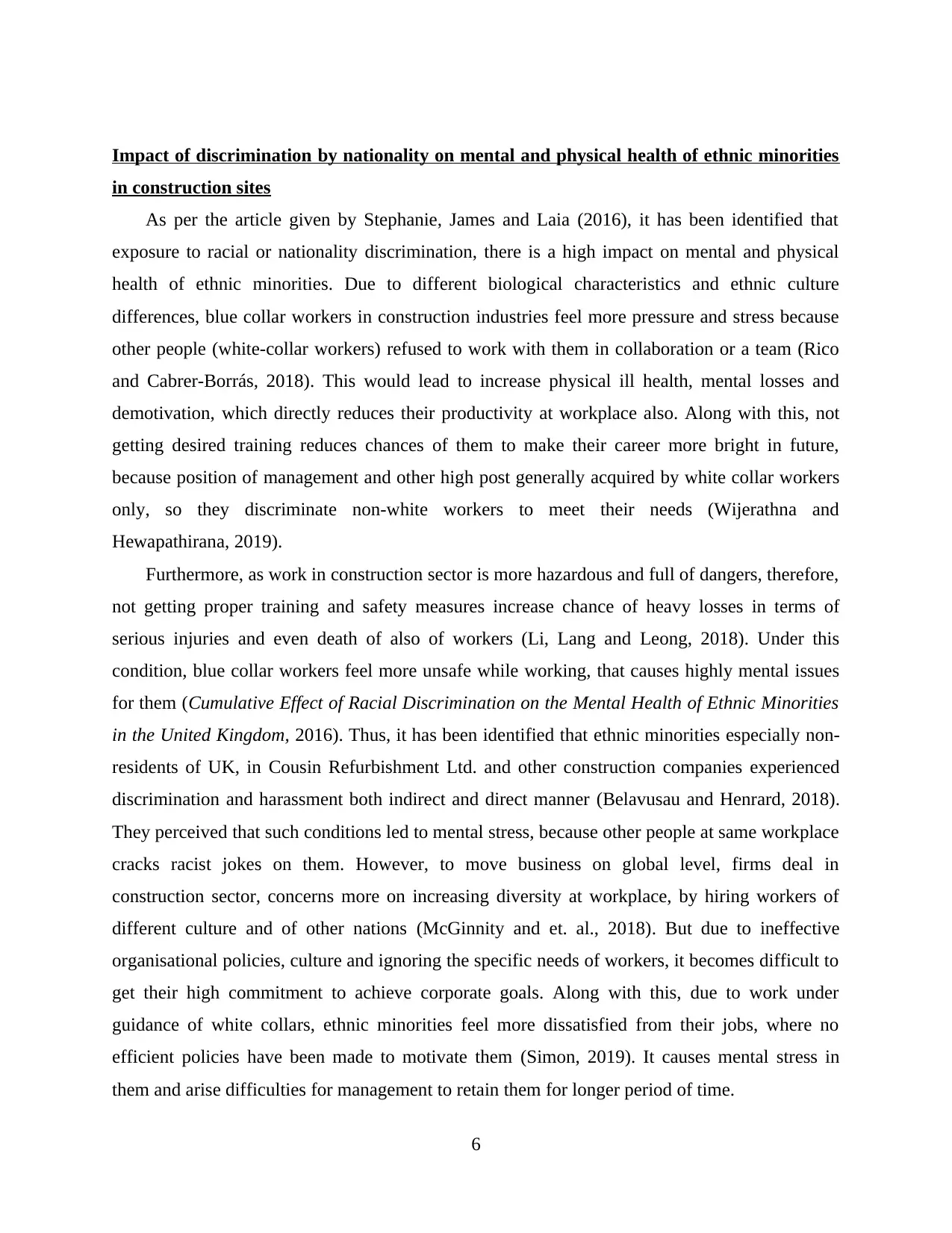
Impact of discrimination by nationality on mental and physical health of ethnic minorities
in construction sites
As per the article given by Stephanie, James and Laia (2016), it has been identified that
exposure to racial or nationality discrimination, there is a high impact on mental and physical
health of ethnic minorities. Due to different biological characteristics and ethnic culture
differences, blue collar workers in construction industries feel more pressure and stress because
other people (white-collar workers) refused to work with them in collaboration or a team (Rico
and Cabrer-Borrás, 2018). This would lead to increase physical ill health, mental losses and
demotivation, which directly reduces their productivity at workplace also. Along with this, not
getting desired training reduces chances of them to make their career more bright in future,
because position of management and other high post generally acquired by white collar workers
only, so they discriminate non-white workers to meet their needs (Wijerathna and
Hewapathirana, 2019).
Furthermore, as work in construction sector is more hazardous and full of dangers, therefore,
not getting proper training and safety measures increase chance of heavy losses in terms of
serious injuries and even death of also of workers (Li, Lang and Leong, 2018). Under this
condition, blue collar workers feel more unsafe while working, that causes highly mental issues
for them (Cumulative Effect of Racial Discrimination on the Mental Health of Ethnic Minorities
in the United Kingdom, 2016). Thus, it has been identified that ethnic minorities especially non-
residents of UK, in Cousin Refurbishment Ltd. and other construction companies experienced
discrimination and harassment both indirect and direct manner (Belavusau and Henrard, 2018).
They perceived that such conditions led to mental stress, because other people at same workplace
cracks racist jokes on them. However, to move business on global level, firms deal in
construction sector, concerns more on increasing diversity at workplace, by hiring workers of
different culture and of other nations (McGinnity and et. al., 2018). But due to ineffective
organisational policies, culture and ignoring the specific needs of workers, it becomes difficult to
get their high commitment to achieve corporate goals. Along with this, due to work under
guidance of white collars, ethnic minorities feel more dissatisfied from their jobs, where no
efficient policies have been made to motivate them (Simon, 2019). It causes mental stress in
them and arise difficulties for management to retain them for longer period of time.
6
in construction sites
As per the article given by Stephanie, James and Laia (2016), it has been identified that
exposure to racial or nationality discrimination, there is a high impact on mental and physical
health of ethnic minorities. Due to different biological characteristics and ethnic culture
differences, blue collar workers in construction industries feel more pressure and stress because
other people (white-collar workers) refused to work with them in collaboration or a team (Rico
and Cabrer-Borrás, 2018). This would lead to increase physical ill health, mental losses and
demotivation, which directly reduces their productivity at workplace also. Along with this, not
getting desired training reduces chances of them to make their career more bright in future,
because position of management and other high post generally acquired by white collar workers
only, so they discriminate non-white workers to meet their needs (Wijerathna and
Hewapathirana, 2019).
Furthermore, as work in construction sector is more hazardous and full of dangers, therefore,
not getting proper training and safety measures increase chance of heavy losses in terms of
serious injuries and even death of also of workers (Li, Lang and Leong, 2018). Under this
condition, blue collar workers feel more unsafe while working, that causes highly mental issues
for them (Cumulative Effect of Racial Discrimination on the Mental Health of Ethnic Minorities
in the United Kingdom, 2016). Thus, it has been identified that ethnic minorities especially non-
residents of UK, in Cousin Refurbishment Ltd. and other construction companies experienced
discrimination and harassment both indirect and direct manner (Belavusau and Henrard, 2018).
They perceived that such conditions led to mental stress, because other people at same workplace
cracks racist jokes on them. However, to move business on global level, firms deal in
construction sector, concerns more on increasing diversity at workplace, by hiring workers of
different culture and of other nations (McGinnity and et. al., 2018). But due to ineffective
organisational policies, culture and ignoring the specific needs of workers, it becomes difficult to
get their high commitment to achieve corporate goals. Along with this, due to work under
guidance of white collars, ethnic minorities feel more dissatisfied from their jobs, where no
efficient policies have been made to motivate them (Simon, 2019). It causes mental stress in
them and arise difficulties for management to retain them for longer period of time.
6
⊘ This is a preview!⊘
Do you want full access?
Subscribe today to unlock all pages.

Trusted by 1+ million students worldwide
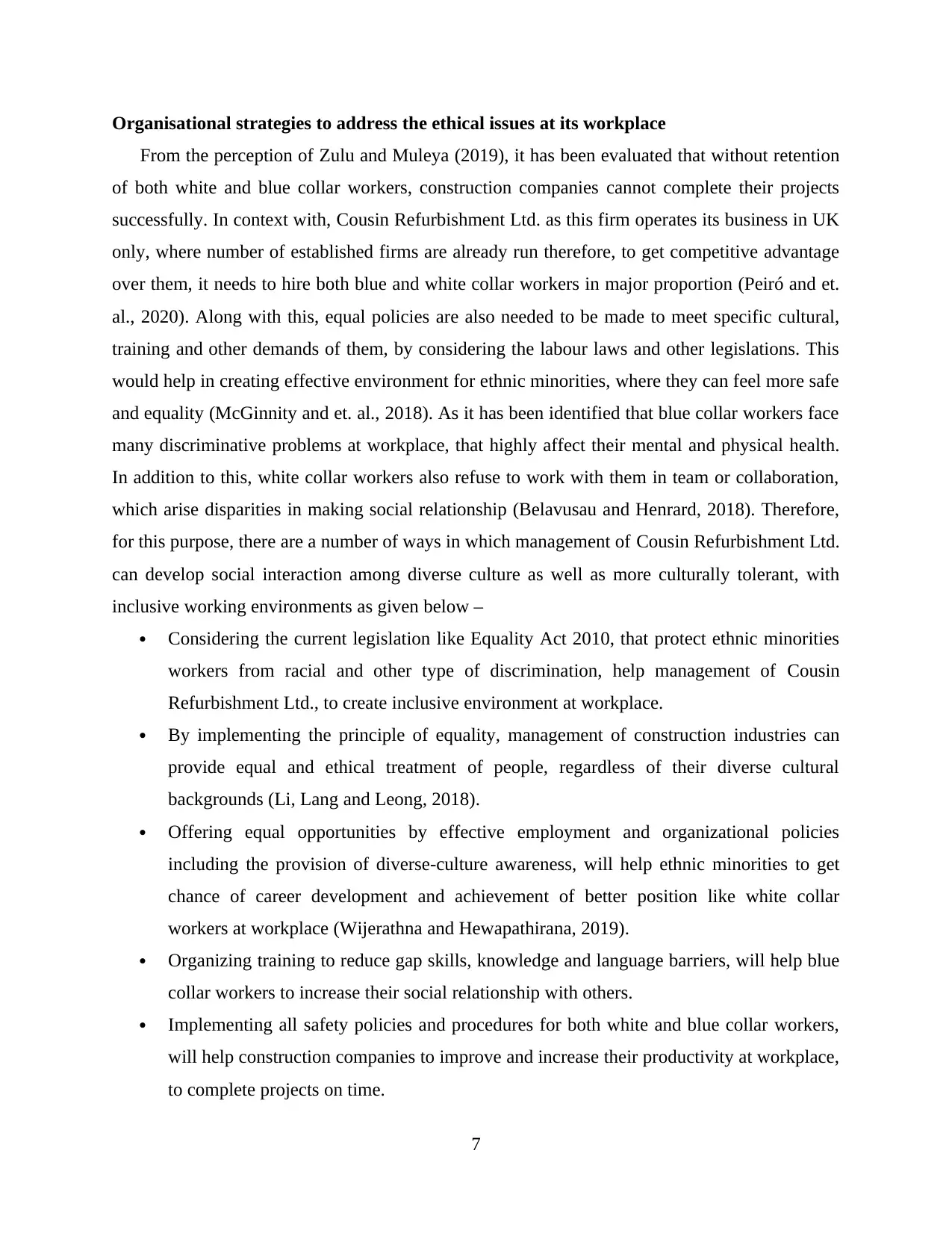
Organisational strategies to address the ethical issues at its workplace
From the perception of Zulu and Muleya (2019), it has been evaluated that without retention
of both white and blue collar workers, construction companies cannot complete their projects
successfully. In context with, Cousin Refurbishment Ltd. as this firm operates its business in UK
only, where number of established firms are already run therefore, to get competitive advantage
over them, it needs to hire both blue and white collar workers in major proportion (Peiró and et.
al., 2020). Along with this, equal policies are also needed to be made to meet specific cultural,
training and other demands of them, by considering the labour laws and other legislations. This
would help in creating effective environment for ethnic minorities, where they can feel more safe
and equality (McGinnity and et. al., 2018). As it has been identified that blue collar workers face
many discriminative problems at workplace, that highly affect their mental and physical health.
In addition to this, white collar workers also refuse to work with them in team or collaboration,
which arise disparities in making social relationship (Belavusau and Henrard, 2018). Therefore,
for this purpose, there are a number of ways in which management of Cousin Refurbishment Ltd.
can develop social interaction among diverse culture as well as more culturally tolerant, with
inclusive working environments as given below –
Considering the current legislation like Equality Act 2010, that protect ethnic minorities
workers from racial and other type of discrimination, help management of Cousin
Refurbishment Ltd., to create inclusive environment at workplace.
By implementing the principle of equality, management of construction industries can
provide equal and ethical treatment of people, regardless of their diverse cultural
backgrounds (Li, Lang and Leong, 2018).
Offering equal opportunities by effective employment and organizational policies
including the provision of diverse-culture awareness, will help ethnic minorities to get
chance of career development and achievement of better position like white collar
workers at workplace (Wijerathna and Hewapathirana, 2019).
Organizing training to reduce gap skills, knowledge and language barriers, will help blue
collar workers to increase their social relationship with others.
Implementing all safety policies and procedures for both white and blue collar workers,
will help construction companies to improve and increase their productivity at workplace,
to complete projects on time.
7
From the perception of Zulu and Muleya (2019), it has been evaluated that without retention
of both white and blue collar workers, construction companies cannot complete their projects
successfully. In context with, Cousin Refurbishment Ltd. as this firm operates its business in UK
only, where number of established firms are already run therefore, to get competitive advantage
over them, it needs to hire both blue and white collar workers in major proportion (Peiró and et.
al., 2020). Along with this, equal policies are also needed to be made to meet specific cultural,
training and other demands of them, by considering the labour laws and other legislations. This
would help in creating effective environment for ethnic minorities, where they can feel more safe
and equality (McGinnity and et. al., 2018). As it has been identified that blue collar workers face
many discriminative problems at workplace, that highly affect their mental and physical health.
In addition to this, white collar workers also refuse to work with them in team or collaboration,
which arise disparities in making social relationship (Belavusau and Henrard, 2018). Therefore,
for this purpose, there are a number of ways in which management of Cousin Refurbishment Ltd.
can develop social interaction among diverse culture as well as more culturally tolerant, with
inclusive working environments as given below –
Considering the current legislation like Equality Act 2010, that protect ethnic minorities
workers from racial and other type of discrimination, help management of Cousin
Refurbishment Ltd., to create inclusive environment at workplace.
By implementing the principle of equality, management of construction industries can
provide equal and ethical treatment of people, regardless of their diverse cultural
backgrounds (Li, Lang and Leong, 2018).
Offering equal opportunities by effective employment and organizational policies
including the provision of diverse-culture awareness, will help ethnic minorities to get
chance of career development and achievement of better position like white collar
workers at workplace (Wijerathna and Hewapathirana, 2019).
Organizing training to reduce gap skills, knowledge and language barriers, will help blue
collar workers to increase their social relationship with others.
Implementing all safety policies and procedures for both white and blue collar workers,
will help construction companies to improve and increase their productivity at workplace,
to complete projects on time.
7
Paraphrase This Document
Need a fresh take? Get an instant paraphrase of this document with our AI Paraphraser
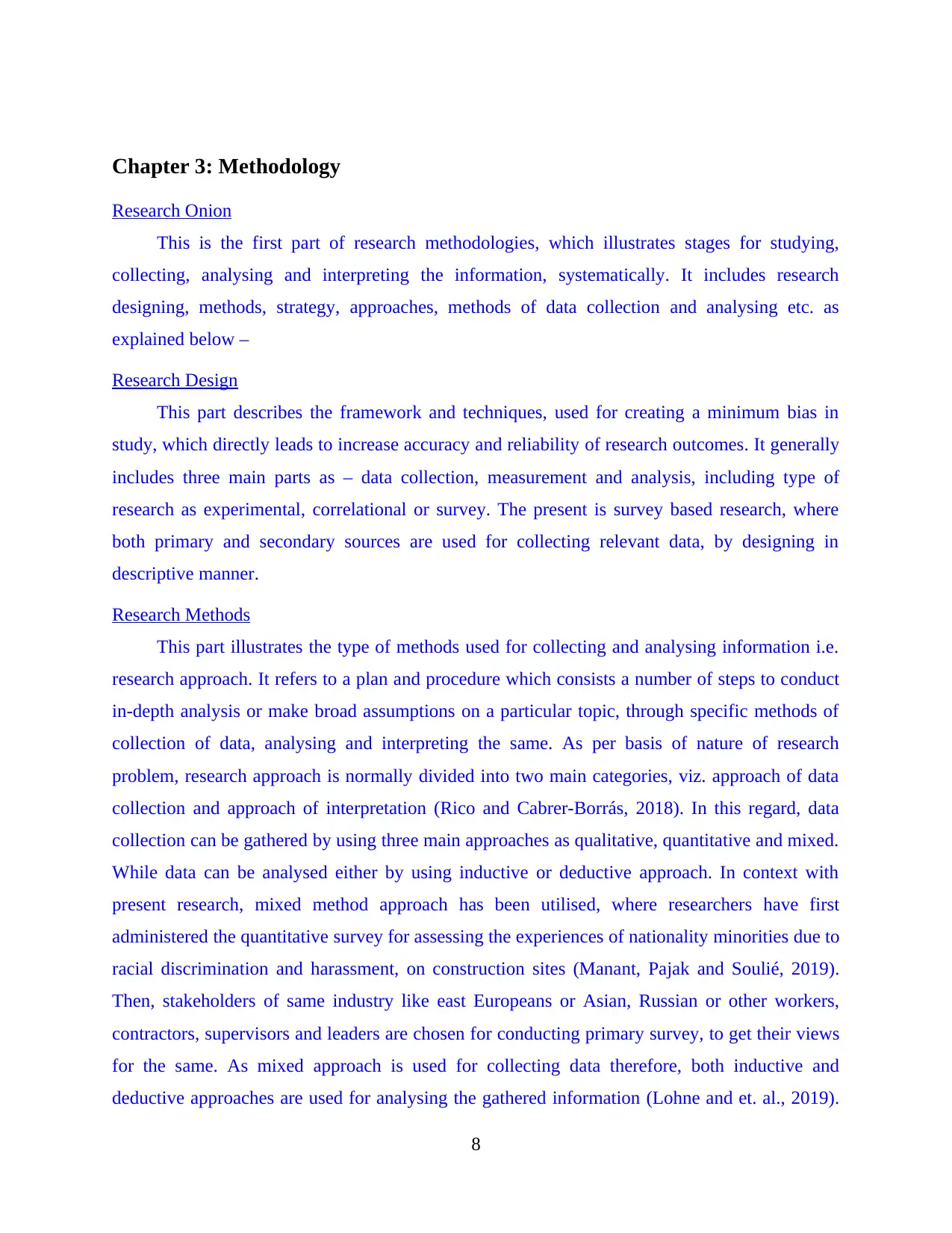
Chapter 3: Methodology
Research Onion
This is the first part of research methodologies, which illustrates stages for studying,
collecting, analysing and interpreting the information, systematically. It includes research
designing, methods, strategy, approaches, methods of data collection and analysing etc. as
explained below –
Research Design
This part describes the framework and techniques, used for creating a minimum bias in
study, which directly leads to increase accuracy and reliability of research outcomes. It generally
includes three main parts as – data collection, measurement and analysis, including type of
research as experimental, correlational or survey. The present is survey based research, where
both primary and secondary sources are used for collecting relevant data, by designing in
descriptive manner.
Research Methods
This part illustrates the type of methods used for collecting and analysing information i.e.
research approach. It refers to a plan and procedure which consists a number of steps to conduct
in-depth analysis or make broad assumptions on a particular topic, through specific methods of
collection of data, analysing and interpreting the same. As per basis of nature of research
problem, research approach is normally divided into two main categories, viz. approach of data
collection and approach of interpretation (Rico and Cabrer-Borrás, 2018). In this regard, data
collection can be gathered by using three main approaches as qualitative, quantitative and mixed.
While data can be analysed either by using inductive or deductive approach. In context with
present research, mixed method approach has been utilised, where researchers have first
administered the quantitative survey for assessing the experiences of nationality minorities due to
racial discrimination and harassment, on construction sites (Manant, Pajak and Soulié, 2019).
Then, stakeholders of same industry like east Europeans or Asian, Russian or other workers,
contractors, supervisors and leaders are chosen for conducting primary survey, to get their views
for the same. As mixed approach is used for collecting data therefore, both inductive and
deductive approaches are used for analysing the gathered information (Lohne and et. al., 2019).
8
Research Onion
This is the first part of research methodologies, which illustrates stages for studying,
collecting, analysing and interpreting the information, systematically. It includes research
designing, methods, strategy, approaches, methods of data collection and analysing etc. as
explained below –
Research Design
This part describes the framework and techniques, used for creating a minimum bias in
study, which directly leads to increase accuracy and reliability of research outcomes. It generally
includes three main parts as – data collection, measurement and analysis, including type of
research as experimental, correlational or survey. The present is survey based research, where
both primary and secondary sources are used for collecting relevant data, by designing in
descriptive manner.
Research Methods
This part illustrates the type of methods used for collecting and analysing information i.e.
research approach. It refers to a plan and procedure which consists a number of steps to conduct
in-depth analysis or make broad assumptions on a particular topic, through specific methods of
collection of data, analysing and interpreting the same. As per basis of nature of research
problem, research approach is normally divided into two main categories, viz. approach of data
collection and approach of interpretation (Rico and Cabrer-Borrás, 2018). In this regard, data
collection can be gathered by using three main approaches as qualitative, quantitative and mixed.
While data can be analysed either by using inductive or deductive approach. In context with
present research, mixed method approach has been utilised, where researchers have first
administered the quantitative survey for assessing the experiences of nationality minorities due to
racial discrimination and harassment, on construction sites (Manant, Pajak and Soulié, 2019).
Then, stakeholders of same industry like east Europeans or Asian, Russian or other workers,
contractors, supervisors and leaders are chosen for conducting primary survey, to get their views
for the same. As mixed approach is used for collecting data therefore, both inductive and
deductive approaches are used for analysing the gathered information (Lohne and et. al., 2019).
8
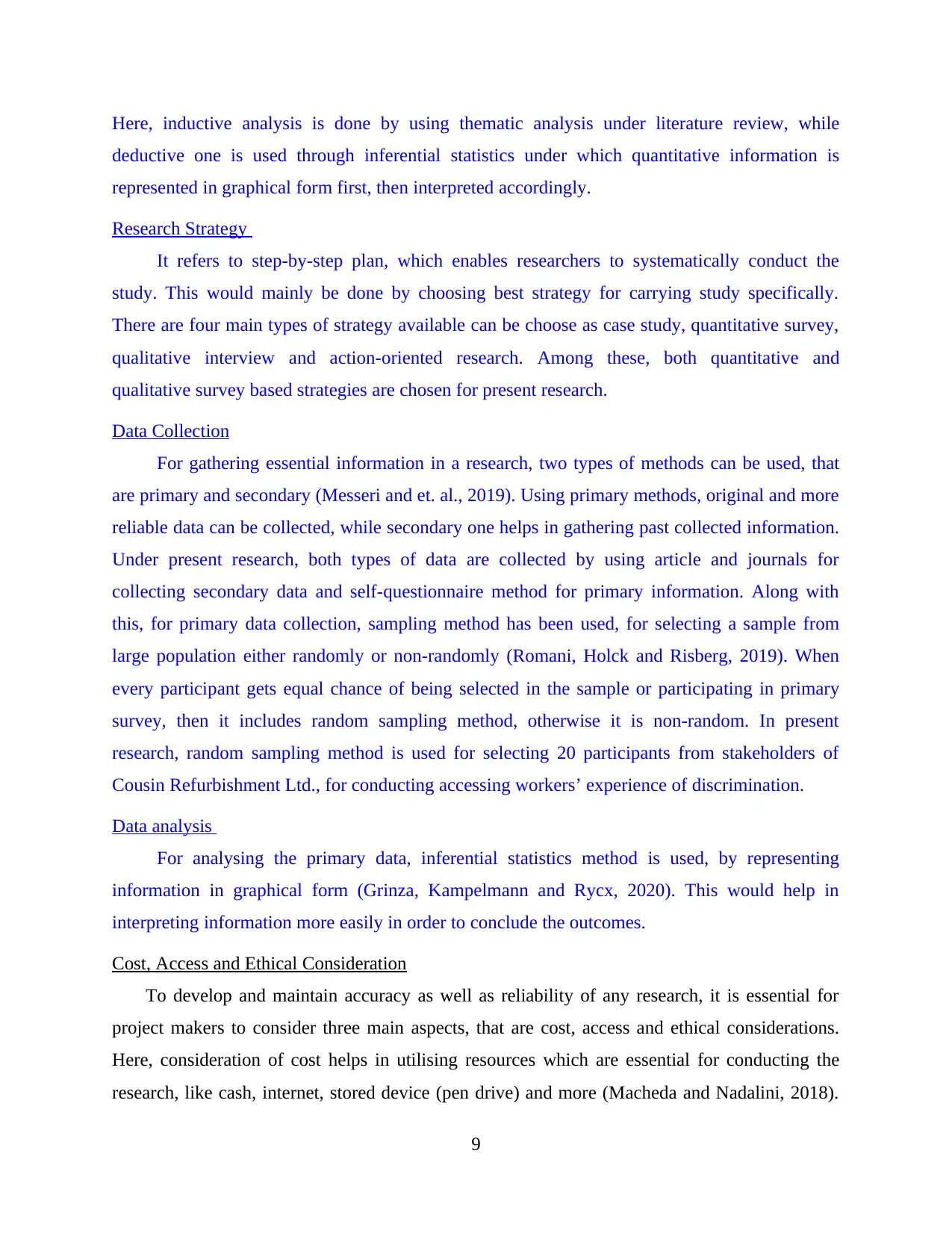
Here, inductive analysis is done by using thematic analysis under literature review, while
deductive one is used through inferential statistics under which quantitative information is
represented in graphical form first, then interpreted accordingly.
Research Strategy
It refers to step-by-step plan, which enables researchers to systematically conduct the
study. This would mainly be done by choosing best strategy for carrying study specifically.
There are four main types of strategy available can be choose as case study, quantitative survey,
qualitative interview and action-oriented research. Among these, both quantitative and
qualitative survey based strategies are chosen for present research.
Data Collection
For gathering essential information in a research, two types of methods can be used, that
are primary and secondary (Messeri and et. al., 2019). Using primary methods, original and more
reliable data can be collected, while secondary one helps in gathering past collected information.
Under present research, both types of data are collected by using article and journals for
collecting secondary data and self-questionnaire method for primary information. Along with
this, for primary data collection, sampling method has been used, for selecting a sample from
large population either randomly or non-randomly (Romani, Holck and Risberg, 2019). When
every participant gets equal chance of being selected in the sample or participating in primary
survey, then it includes random sampling method, otherwise it is non-random. In present
research, random sampling method is used for selecting 20 participants from stakeholders of
Cousin Refurbishment Ltd., for conducting accessing workers’ experience of discrimination.
Data analysis
For analysing the primary data, inferential statistics method is used, by representing
information in graphical form (Grinza, Kampelmann and Rycx, 2020). This would help in
interpreting information more easily in order to conclude the outcomes.
Cost, Access and Ethical Consideration
To develop and maintain accuracy as well as reliability of any research, it is essential for
project makers to consider three main aspects, that are cost, access and ethical considerations.
Here, consideration of cost helps in utilising resources which are essential for conducting the
research, like cash, internet, stored device (pen drive) and more (Macheda and Nadalini, 2018).
9
deductive one is used through inferential statistics under which quantitative information is
represented in graphical form first, then interpreted accordingly.
Research Strategy
It refers to step-by-step plan, which enables researchers to systematically conduct the
study. This would mainly be done by choosing best strategy for carrying study specifically.
There are four main types of strategy available can be choose as case study, quantitative survey,
qualitative interview and action-oriented research. Among these, both quantitative and
qualitative survey based strategies are chosen for present research.
Data Collection
For gathering essential information in a research, two types of methods can be used, that
are primary and secondary (Messeri and et. al., 2019). Using primary methods, original and more
reliable data can be collected, while secondary one helps in gathering past collected information.
Under present research, both types of data are collected by using article and journals for
collecting secondary data and self-questionnaire method for primary information. Along with
this, for primary data collection, sampling method has been used, for selecting a sample from
large population either randomly or non-randomly (Romani, Holck and Risberg, 2019). When
every participant gets equal chance of being selected in the sample or participating in primary
survey, then it includes random sampling method, otherwise it is non-random. In present
research, random sampling method is used for selecting 20 participants from stakeholders of
Cousin Refurbishment Ltd., for conducting accessing workers’ experience of discrimination.
Data analysis
For analysing the primary data, inferential statistics method is used, by representing
information in graphical form (Grinza, Kampelmann and Rycx, 2020). This would help in
interpreting information more easily in order to conclude the outcomes.
Cost, Access and Ethical Consideration
To develop and maintain accuracy as well as reliability of any research, it is essential for
project makers to consider three main aspects, that are cost, access and ethical considerations.
Here, consideration of cost helps in utilising resources which are essential for conducting the
research, like cash, internet, stored device (pen drive) and more (Macheda and Nadalini, 2018).
9
⊘ This is a preview!⊘
Do you want full access?
Subscribe today to unlock all pages.

Trusted by 1+ million students worldwide
1 out of 27
Related Documents
Your All-in-One AI-Powered Toolkit for Academic Success.
+13062052269
info@desklib.com
Available 24*7 on WhatsApp / Email
![[object Object]](/_next/static/media/star-bottom.7253800d.svg)
Unlock your academic potential
Copyright © 2020–2025 A2Z Services. All Rights Reserved. Developed and managed by ZUCOL.




